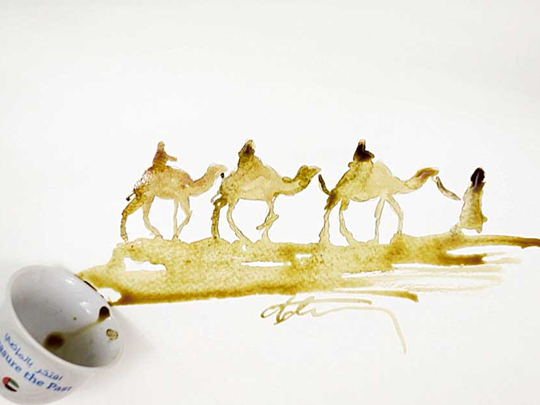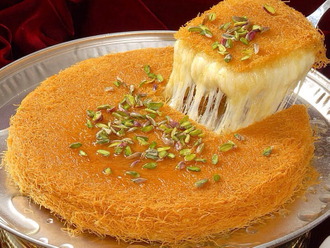
Dubai: An Emirati visual artist based in Abu Dhabi is turning significant life events and social issues into artistic pieces to share her feelings with society.
Whether it is deep anguish about Emirati martyrs or the death of an Emirati firefighter in the line of duty, happiness at celebrating Emirati Women’s day, or simply reflecting on events that concern society, especially Emiratis, Ashwaq Abdullah says she likes her work to have an impact on her audience.
She showcases her creativity through various mediums, sometimes combining art with stop-motion videos and using edible ingredients, including painting with Arabic coffee as a symbol of her culture.
Ashwaq Abdullah with her painting of the Dubai skyline. She uses stop-motion videos and edible ingredients in her art.
“My art has always been centred around the community and our culture. I like to do art for humanity, with the hope that it could have a social impact,” said Abdullah, who holds a degree in graphic design, a minor in interior design and has been on the art scene for the past nine years.
“If there is a particular topic that matters to [society] and they have certain feelings about it, through art, I’m able to share with them the same emotions,” said Abdullah.
Recent artworks by Abdullah have triggered many reactions from the community, and these works she says are a way to pay tribute to figures who contributed and served the UAE.
On her social media accounts, mainly Instagram and Facebook, Abdullah has begun to attract thousands of followers.
“The tragic loss of Ameera Bin Karam, who was the Pink Caravan director and a pioneer woman in Sharjah, made me do an art piece as a tribute to her. A watercolour on paper, it drew many reactions from the community,” said Abdullah.
Among other artworks paying tributes to people are some that honour the sacrifices of Emirati martyrs.
“I dedicated several pieces in their honour. In one, I attached a dried flower on paper and drew tears [in the colours of the army] dropping from the flower,” she said.
A painting of Shaikh Mohammad Bin Zayed greeting Pope Francis during his Vatican visit.
Similarly, firefighter Jasem Eisa Al Beloushi, who died while saving others during a plane landing incident at Dubai International Airport, has been represented in watercolour on paper.
“He is shown holding the plane while smoke is painted rising into the sky. It depicts the immense sacrifice he made to save the passengers.”
Abdullah believes that social media is a powerful tool to promote art.
“By combining my art with stop-motion videos, I deliver messages of my art work on photo-sharing apps like Instagram and Facebook. People like to see videos that show each stage of the piece before it is complete. A lot of hard work and editing goes into each frame.”
A stop-motion video posted on her account celebrates Emirati Women’s Day by showing the various roles women take up in the UAE, including in the military.
“An Emirati woman is the mother of the martyr, an indiviual who works in diverse fields, a committed professional... this is all represented in the painting. At the same time, I wanted to show that she is attached to the traditions and culture of her country, by showing her in an abaya and shayla,” she said.
A unique work is a painting on paper of His Highness Shaikh Mohammad Bin Zayed, Crown Prince of Abu Dhabi and Supreme Commander of the Armed Forces, shaking hands with the Pope.
“{The visit to the Vatican] inspired me to do something to emphasise tolerance in the UAE and how we are all looking for world peace,” she said.
A large aspect of her work is the inclusion of edible items in her art, which she took up recently. “The challenge with this art is that I have to match the shape of the sketch with the art piece. In one piece, I added a croissant as a camel’s back.”
Among Ashwaq Abdullah’s works are paintings paying homage to Emirati martyrs and the UAE Armed Forces.
Though coffee art is not new, Abdullah decided to use Arabic coffee to colour her drawings, sometimes mixing it with different spices to create varying shades.
“The trick is to add spices to either get a darker shade or a lighter one,” she says.
Other works of art highlighting the UAE culture and history include a recent commissioned project by the Four Seasons Hotel, Abu Dhabi, where Abdullah delivered seven sculptures and two acrylic paintings on canvas showing iconic structures representing each emirate.
“It is important for visitors to see works that describe the country and its history. Each bronze sculpture promoted one emirate and showed the cultural side of, for example, Al Fahidi Tower in Al Bastakiya, Qasr Al Hosn in Abu Dhabi and Sharjah Culture Roundabout.”
The other sculptures promoted Umm Al Quwain’s castle, Ras Al Khaima’s mountainous areas, Fujairah’s diving culture and Ajman’s unique architectural designs, she said.
“I want to always make people feel that I’m close to them and want to represent my country outside the UAE with my work.”
She believes more Emiratis are getting involved in art, which shows that there is a growing awareness and interest in it.
“There are many young talented artists emerging in the UAE, and what I noticed is that more Emiratis are now interested in visiting art exhibitions and analysing artworks as compared to before.”
She is of the firm belef that Emirati artists should use art to communicate their culture to other nationalities.








